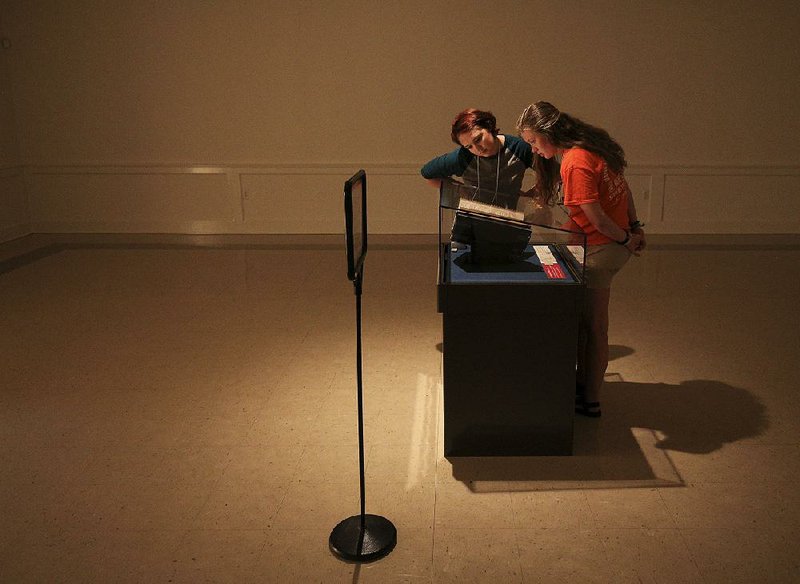CONWAY -- Four-hundred years after William Shakespeare's b̶i̶r̶t̶h̶ death*, the first comprehensive collection of his plays is touring the United States with a stop through July 12 at the University of Central Arkansas, the home of the Arkansas Shakespeare Theatre company.
Along with the kings, princes and lovers of Shakespeare's plays comes unusually heavy security as the prized collection, called simply First Folio and likely worth millions of dollars, visits all 50 states, Washington, D.C., and Puerto Rico.
Published in 1623, seven years after Shakespeare's death on April 23 at age 52, the leather-bound First Folio weighs almost 5 pounds and holds 36 of Shakespeare's 38 plays, including 18 appearing in print for the first time. Among those 18 that otherwise might have been lost are Macbeth, Julius Caesar, Twelfth Night, The Tempest and As You Like It.
"Who can imagine life without Julius Caesar?" said Garland Scott, spokesman for Folger Shakespeare Library in Washington.
The first editions on tour are among the Folger's 82 copies, the most in any collection. Just 233 of the estimated 750 copies printed are known to remain.
One of the roughly 900-page books sold for $6.2 million in 2001 and for $5.2 million in 2006. Compare that with its cost in the 17th century -- 1 British pound, or 20 shillings, about $200 to $250 today.
Compiled by two of Shakespeare's fellow actors, the First Folio begins with The Tempest. The name Shakespeare is as large as it can be on the book's title page. Just as it would today, that billing suggests that the author's name was "a major selling point even years after his death," according to exhibition materials.
Folios were large books usually reserved for Bibles or important works of history, law and science. Plays were not considered literature worthy of such publication at that time, and Shakespeare was one of the first English playwrights whose works were compiled into a folio, Scott said.
Folios consisted of the largest sheets of paper used in printing then, said Paige Reynolds, an associate English professor at UCA, Shakespeare expert and actress in the Shakespeare Theatre.
"Most of the time, the folios signified the importance of documents. So, there's also something really important that these gentlemen [Shakespeare's actor friends] were trying to say about using that format," said Reynolds, who called the book "a priceless treasure."
The First Folio also was the first publication to divide Shakespeare's plays into comedies, histories and tragedies. Inside, before the plays begin are poetic tributes to him. Among them is a two-page poem by Ben Jonson, whom Scott described as a "rival playwright and poet ... a great friend and drinking buddy" of Shakespeare's.
Making the First Folio even more important is that there are no known handwritten manuscripts of Shakespeare's plays, Scott said.
The First Folio arrived at UCA by FedEx in a vehicle with two drivers and one courier "who travels with it wherever it goes," said Barclay McConnell, director of the university's Baum Gallery, where the book is on display daily from 12:30-7:30 p.m. except on Sundays and Mondays.
Admission is free, and the afternoon and early evening times are offered to attract visitors who attend plays currently being performed on campus by the Shakespeare Theatre.
Visitors can leaf through a facsimile of the First Folio, a gold-leafed book guarded by a UCA police officer and displayed in a transparent case in a dark room to prevent light from fading the print.
The case contains two alarms, set to warn of anything from a theft attempt to a hard bump or a problem with humidity and temperature levels, which are recorded and shared daily with the Folger library, McConnell said.
Work renovating the Baum Gallery began two years ago to get it up to the required standards to house something as old and valuable as the First Folio, McConnell said.
"We gathered climate data on the Baum Gallery for a year and sent it to the Folger library," she said. "Based on that data, they created a prescription for each [tour] site" for a specific amount of moisture-absorbent silica gel that goes inside a drawer beneath the book.
For the display, the First Folio rests open to show one of Shakespeare's most famous lines -- the one where Hamlet ponders aloud why people choose to live and says: "To be or not to be, that is the Question."
Though a master of the English language, Shakespeare was writing during the Elizabethan era, before the language was as standardized as it is today and when a lower-case s was treated as a "long s" and looked more like today's f. So, the word "Question" looks more like "Queftion" in the First Folio.
Rebekah Scallet is artistic director for the Arkansas Shakespeare Theatre, which is celebrating its 10th anniversary.
Scallet said the First Folio is her "starting text" in deciding how Shakespeare would have wanted his words spoken aloud.
The First Folio "has a very different punctuation ... than most modern texts do," she said. "It has words that are capitalized in the middle of the sentence." But those capitalized letters help her to know which words to stress in a performance.
Likewise, commas help Scallet know when Shakespeare wanted an actor to pause.
"The big difference in punctuation is that the sentences [were] much longer" than they are today, she said. "A lot of the sentences would appear to be run-on sentences ... with lots of commas and semicolons and colons."
A sentence in the First Folio, for instance, might run "12 or 13 lines long," while "modern editions ... break that down to eight or nine," Scallet said.
Scott said the book's gold-leaf edging and leather binding were likely added by a subsequent owner in the 19th century. Only one of the First Folio copies, she said, is still in its original binding. That helps explain the excellent condition of the historic book on display at UCA.
The exhibition, which also includes costumes and props from previous Arkansas Shakespeare Theatre performances, has attracted a stream of visitors, McConnell said.
Among them Thursday were retired English and French teacher Sue King of Hot Springs, who took her grandson, Aiden King, to see the exhibition.
King said her love of Shakespeare dates to her high school days in the small town of Wilmot where she read all of Shakespeare's plays thanks to an English teacher there.
Aiden said he was surprised at the condition and the size of the First Folio.
"I was expecting like a small, worn-out, little book," he said.
Aiden, 10, hasn't read any of Shakespeare's plays yet, but he likely will see one soon.
"We're going to come back" and enjoy the outdoor performance of A Midsummer Night's Dream, his grandmother said.
The Folger library has organized the First Folio tour in partnership with the Cincinnati Museum Center and the American Library Association.
State Desk on 06/12/2016
*CORRECTION: The First Folio, a comprehensive collection of William Shakespeare’s plays, is touring the country during the 400th anniversary of his death in 1616. This article incorrectly described the anniversary.

